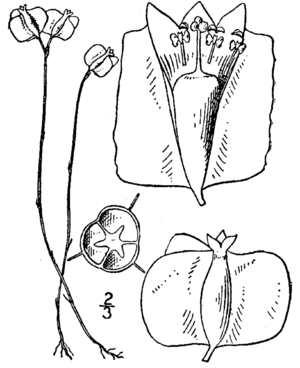Burmannia biflora
| Burmannia biflora | ||||||||||||
|---|---|---|---|---|---|---|---|---|---|---|---|---|

Burmannia biflora |
||||||||||||
| Systematics | ||||||||||||
|
||||||||||||
| Scientific name | ||||||||||||
| Burmannia biflora | ||||||||||||
| L. |
Burmannia biflora is a plant type from the family of Burmanniaceae . It wasfirst describedby Carl von Linné in 1753and is thereforethe longest known species of the genus Burmannia, along with the Asian Burmannia disticha .
description
Burmannia biflora is an annual, herbaceous and - unlike many other species of the genus - leaf-green plant that reaches a height of 3 to 18 centimeters. Leaves are missing at the base; the awl-shaped to lanceolate leaves distributed over the stem are 1 to 4 millimeters long and 0.2 to 1 millimeters wide. The loosely zymous inflorescences have two to twelve flowers . The bracts are also awl-shaped to lanceolate and 1.5 to 3.2 millimeters long.
The flowers, which are only up to 1 millimeter long, are three-winged along the flower tube and 3 to 6 millimeters high. The wings are blue and each up to 2.5 millimeters wide. The blue to purple flower envelope is six-lobed, the lobes cream-colored. The outer lobes are triangular and 0.5 to 1 millimeter long, the inner upright, elliptical and 0.4 to 0.8 millimeters long. The capsule fruit is 2 to 3.5 millimeters long.
distribution
Burmannia biflora is found from the south to the southeast of the United States and in Cuba . Their northernmost occurrences are in North Carolina and Virginia ; This makes it one of the few species of the mostly tropical family that has penetrated far into temperate zones. It grows on the edges of ponds and streams, in savannas or swamps at altitudes of 0 to 100 meters.
proof
- Flora of North America , Vol. 26, pp. 487-488, online